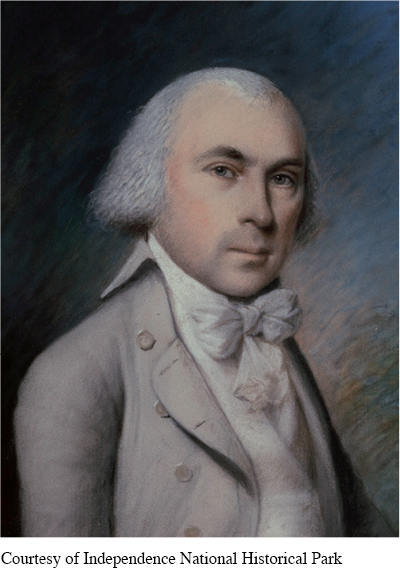The Constitutional Convention of 1787
The fifty-five delegates who attended the Philadelphia convention were composed of white, educated men of property, mainly lawyers, merchants, and planters. Only eight had signed the Declaration of Independence eleven years earlier. The elite status of the delegates and the absence of many leading patriots raised concern among those who saw the convention as a threat to the rights of states and of citizens. Not wanting to alarm the public, delegates agreed to meet in secret until they had hammered out a new framework of government.
On May 25, the convention opened, and delegates quickly turned to the key question: Revise the Articles of Confederation or draft an entirely new document? The majority of men came to Philadelphia with the intention of amending the Articles. However, a core group who sought a more powerful central government had met before the convention and drafted a plan to replace the Articles. This Virginia Plan proposed a strong centralized state, including a bicameral (two-house) legislature in which representation was to be based on population. Members of the two houses would select the national executive and the national judiciary, and would settle disputes between states. Although most delegates opposed the Virginia Plan, it launched discussions in which strengthening the central government was assumed to be the goal.

Discussions of the Virginia Plan raised another issue that nearly paralyzed the convention: the question of representation. Heated debates pitted large states against small states, even though political interests were not necessarily determined by size. Yet delegates held on to size as the critical issue in determining representation. In mid-June, William Patterson introduced the New Jersey Plan, which highlighted the needs of smaller states. In this plan, Congress would consist of only one house, with each state having equal representation.
With few signs of compromise, the convention finally appointed a special committee to hammer out the problem of representation. Their report broke the logjam. Members of the House of Representatives were to be elected by voters in each state; members of the Senate would be appointed by state legislatures. Representation in the House would be determined by population—counted every ten years in a national census—while in the Senate, each state, regardless of size, would have equal representation. While the Senate had more authority than the House in many areas, only the House could introduce funding bills.
Included within this compromise was one of the few direct considerations of slavery at the Philadelphia convention. With little apparent debate, the committee decided that representation in the House of Representatives was to be based on an enumeration of the entire free population and three-fifths of “all other persons,” that is, slaves. If delegates had moral scruples about this three-fifths compromise, most found them outweighed by the urgency of settling the troublesome question of representation.
Still, slavery was on the minds of delegates. In the same week that the Philadelphia convention tacitly accepted the institution of slavery, the confederation congress in New York City outlawed slavery in the Northwest Territory. News of that decision likely inspired representatives from Georgia and South Carolina to insist that the Constitution protect the slave trade. Delegates in Philadelphia agreed that the importation of slaves would not be interfered with for twenty years. Another provision guaranteed the return of fugitive slaves to their owners. At the same time, northern delegates insisted that the three-fifths formula be used in assessing taxation as well as representation, ensuring that the South paid for the increased size of its congressional delegation with increased taxes.
Two other issues provoked considerable debate in the following weeks. All delegates supported federalism, a system in which states and the central government shared power, but they disagreed over the balance of power between them. They also disagreed over the degree of popular participation in selecting national leaders. The new Constitution increased the powers of the central government significantly. For instance, Congress would now have the right to raise revenue by levying and collecting taxes and tariffs and coining money; raise armies; regulate interstate commerce; settle disputes between the states; establish uniform rules for the naturalization of immigrants; and make treaties with foreign nations and Indians. But Congress could veto state laws only when those laws challenged “the supreme law of the land,” and states retained all rights that were not specifically granted to the federal government.
One of the important powers retained by the states was the right to determine who was eligible to vote, but the Constitution regulated the influence eligible voters would have in national elections. Members of the House of Representatives were to be elected directly by popular vote for two-year terms. Senators—two from each state—were to be selected by state legislatures for a term of six years. Selection of the president was even further removed from voters. The president would be selected by an electoral college, and state legislatures would decide how to choose its members. Finally, the federal judicial system was to be wholly removed from popular influence. Justices on the Supreme Court were to be appointed by the president and approved by the Senate. Once approved, they served for life to protect their judgments from the pressure of popular opinion.
With the final debates concluded, delegates agreed that approval by nine states, rather than all thirteen, would make the Constitution the law of the land. Some delegates sought formal reassurance that the powers granted the federal government would not be abused and urged inclusion of a bill of rights, like the Virginia Declaration of Rights. But weary men eager to finish their business voted down the proposal. On September 17, 1787, the Constitution was approved and sent to the states for ratification.
Exploring American HistoriesPrinted Page 220
Exploring American Histories Value EditionPrinted Page 163
Chapter Timeline